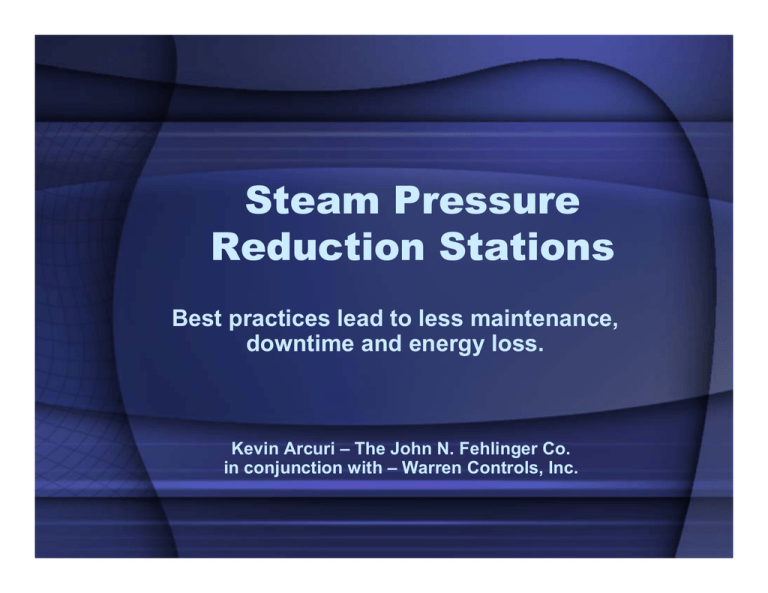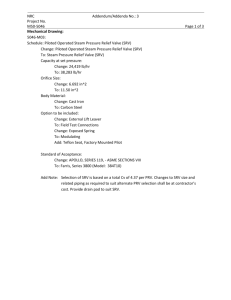Steam Pressure Reduction Stations - International District Energy
advertisement

Steam Pressure Reduction Stations Best practices lead to less maintenance, downtime and energy loss. Kevin Arcuri – The John N. Fehlinger Co. in conjunction with – Warren Controls, Inc. Function: Maintain a reduced pressure under a range of flow conditions. 100 10 10,000 # / Hr. Why are Steam Reducing Valves Required? • Satisfy load requirements of steam consuming equipment • A variety of pressures may be required Properties of Steam • Compressibility Volume Occupied by a Pound of Steam Specific Volume 27.0 Ft3 / lb 3.9 100 psig 17.8 6.8 50 psig 10 psig Atmosphere Properties of Steam • Large Quantities of Heat Available 970 BTU / Lb. Latent Heat at Atmosphere Properties of Steam • Enthalpy remains close to constant during reasonable pressure reductions 100 PSIG 10 PSIG Total Heat = 1189 BTU / Lb. Total Heat = 1160 BTU / Lb. Latent Heat = 880 BTU / Lb. Latent Heat = 952 BTU / Lb. Sensible Heat = 309 BTU / Lb. Sensible Heat = 208 BTU / Lb. 3.9 Ft3 / Lb. 16.2 Ft3 / Lb. 338˚F 239˚F Saturation Temp 10 PSIG, approx 239˚F Terminology 1. Accuracy of Regulation – expressed as a percent of controlled pressure. i.e. 90% accuracy means 10% error from set point to achieve rated valve capacity Terminology 2. a) Reverse Acting – an increase in measured variable produces a decrease in signal output. b) Direct Acting – an increase in measured variable produces an increase in signal output. Terminology 3. Normally Closed or Open – Position of valve on loss of operating medium. Terminology 4. Flow Coefficient Cv – A dimensionless number defined as 60˚F water flowing at 1 gallon / minute with a 1 PSI pressure drop across the controlled element (valve). Valves are rated for capacity by a Cv number in a prescribed ISA test procedure. Terminology 5. Supply Pressure Effect – The change in controlled set point caused by change in supply pressure, usually expressed as a ratio of the two pressures. Example: 10 to 1 ratio can mean for every 10 PSI change in supply pressure the set point changes by 1 PSI. Terminology 6. a) Turndown – The range of flow over which a valve must operate. b) Rangeability – The ratio of maximum rated flow of a valve divided by its minimum controllable flow as stated by the manufacturer. Terminology 7. a) Dead End Service – A process which at times will require zero flow and complete closure of the valve. b) Seat tightness – The degree of leakage permissible across a closed valve as defined by ANSI. Five classes range from 0.5% to zero leakage. c) Steam Tight – Generally accepted as ANSI Class IV shut off with 0.01% permissible leakage. Terminology 8. a) Pressure Boundary – Those valve parts which contain the line pressure and prevent it from reaching atmosphere. b) Trim – The internal valve parts that throttle the flow. Usually the valve plug, stem, seat and cage. c) Actuator – The assembly which provides the force to operate the valve. Design Features • • • • • • ANSI Face to Face ANSI Leakage Class Serviceability (Cage Trim) Actuator Maintenance Flow Capacity Pressure Drop Capability PRV Station Design Considerations • • • • • • Function Sizing (By Mfg’s Programs) Piping Turndown Requirements Safety Noise Typical: Major PRV Station 1. Continuous Service (Heating, A/C & DHW a) b) c) d) Design Load 15,000 Lbs./Hr. Minimum Load – Dead End Supply Pressure 150 PSIG Nominal Outlet Pressure 12 – 15 PSIG 2. Location of PRV Station a) Basement Mechanical Space b) Community Center above ( 80 dBA Limit ) 3. Safety Issues a) Relief Valve Venting Difficulty Type of System 1. Turndown approaching 100 : 1 a) 1/3 – 2/3 ( Lead / Lag ) b) Split Range Systems c) Transfer ( Switching Systems ) Safety - Relief valve sizing N ( 4” x 6” ) P ( 4” x 6” ) Q ( 6” x 8” ) Set Pr 3% 10% 3% 10% 10 4899 5032 7202 7398 12470 12808 17950 18442 15 5808 6109 8685 8991 15040 15549 21650 22389 20 6917 7186 10170 10565 17600 18290 25350 26336 Vent Line 10” Drip Pan Elbow 8” Exhaust Header 16,000 # / Hr. (10”) 3% 10% R ( 6” x 8” ) 3% Set Pressure 15 psig Q orifice 6x8 R.V. Cap 15,549 10% System Protection 1. Relief Valve ( Difficult to vent out of the Building ) 2. ASME Code B31.1 permits elimination of a relief valve if two stage reduction is used, if both stages can be set at the safe working pressure of the equipment being served or if single stage reduction is used with a trip stop shut off valve. a) Single Stage (No Redundancy) b) Two Stage – with Safety Shut Off Pipe Sizing ≈ 6,000 to 8,000 ft / min Max Steam Flow # / Hr. Steam Pressure (PSIG) 5 10 20 40 60 80 100 150 10,000 10 8 8 6 5 5 4 4 12,000 10 10 8 6 6 5 5 4 14,000 12 10 8 8 6 5 5 4 16,000 12 10 10 8 6 6 5 5 Inlet Pipe 4” Outlet Pipe 8” Prediction Method Flow Factor Decibels ∆P / P1 Factor 83 +10 73 Low High Flow Flow Flow Rate Lbs. / Hr. SPL = 83 dBA Resultant Noise = 93 dBA = 83 dBA Pressure Drop Ratio SPL = 10 dBA (High Flow) (Low Flow) Noise Attenuation Options • • • • Silencer – 20 dBA Diffuser – 5 to 7 dBA Acoustic Insulation – 5 to 10 dBA / Inch Schedule 80 Pipe – 3 to 5 dBA Additional Safety Automatic Shut Down Valve Manual Reset SW HP Steam PRV Station LP Steam SSO T 120 VAC Vent To SSO Review of Advantages to 2-Stage Parallel Reducing Stations 1. If one stage fails the other stage automatically takes full pressure drop 2. The rangeability of the valve system is increased to 130 : 1 3. Pneumatically operated controls require less maintenance than steam pilots 4. Valves fail closed on loss of signal Review of Advantages to 2-Stage Parallel Reducing Stations 5. Relief Valve, outside vent pipe and exhaust head can be eliminated. 6. Overall Installed cost can be less. 7. Best overall design for safety, recovery from event, longevity of components, installed system noise and controlled set point over a broad range of loads. In Closing… • Please stop by the Warren Controls booth during your next break for further questions and a copy of ValveWorks® control valve sizing & selection software. • Thank you for your attention.
